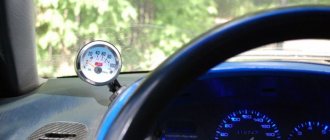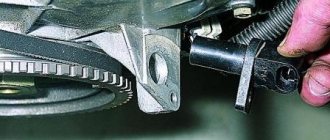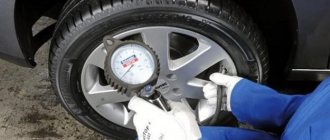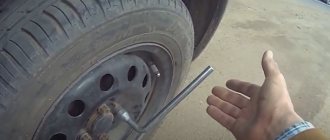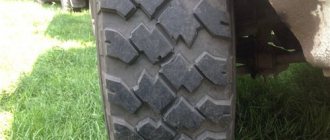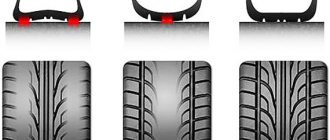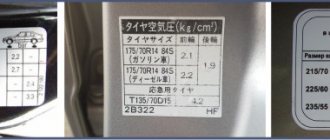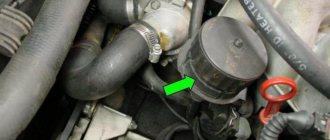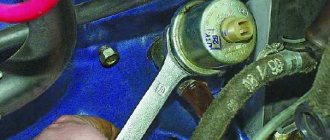After starting the engine of a VAZ 2108, 2109, 21099 car, the oil pressure warning lamp on the instrument panel lights up, or when the car is moving, the pressure lamp lights up suddenly. The reasons for this situation in the operation of a carburetor engine are both a malfunction of the engine itself and a malfunction of electrical equipment.
The engine oil pressure indicator light is on (reasons)
1. The tip of the wire fell off the output of the oil pressure sensor in the cylinder head.
Check if this is true and fix the problem.
2. The engine oil pressure sensor itself is faulty, or its electrical circuit is faulty.
Turn on the ignition, remove the wire from the oil pressure sensor and touch it to the vehicle ground (engine, body...). If the light goes out, the sensor is faulty; if not, its electrical circuit is faulty. Or, for greater accuracy, check the pressure in the lubrication system using a pressure gauge.
3. Low oil level in the engine crankcase.
Let the engine sit for 15 minutes, then check the level by pulling out the dipstick. Add oil if necessary.
4. Low engine idle speed.
When the crankshaft speed drops below 650 rpm, the oil pressure warning light may blink or clearly illuminate. Adjust idle speed. The norm is 750-850 rpm.
5. Engine oil pump is faulty.
6. Engine oil filter is faulty.
7. The oil intake of the oil pump in the engine sump is dirty.
Remove the pan and clean the oil intake.
Five more articles on the site on VAZ car engines
The owner of the Nine will most likely find out that there is a VAZ 2109 oil pressure sensor and an oil level sensor in the engine compartment when the indicator on the instrument panel lights up red, indicating that there are problems with the oil pressure level. And then many questions immediately arise, including what kind of oil should be poured into the system, whether its volume is sufficient, but most importantly, whether this small device has deteriorated. Let's take a closer look at what an oil pressure controller is, what its operating principle is, and how accurately its performance can be determined.
Oil pressure sensor VAZ 2108, 2109, 21099
Using the example of the MM120D engine oil pressure sensor for VAZ 2108, 21081, 21083, 2109, 21091, 21093, 21099 cars, we will analyze why it is needed, how it works, what malfunctions it has, and also determine its applicability.
Oil pressure sensor in the lubrication system of carburetor engines (2108, 21081, 21083) of VAZ 2108, 2109, 21099 cars
— What is an engine oil pressure sensor used for?
An oil pressure sensor working in conjunction with an emergency oil pressure warning lamp is necessary to monitor the oil pressure in the engine lubrication system. If the oil pressure decreases, the sensor closes the electrical circuit of the warning lamp and it lights up, signaling to the driver that there is a malfunction in the car’s engine.
— Where is the oil pressure sensor installed on VAZ 2108, 2109, 21099 cars
The oil pressure sensor on the engines of VAZ 2108, 2109, 21099 cars and their modifications is installed in the cylinder head on the right side, near the intake manifold. It is threaded into a special hole. A wire tip is attached to its output to the emergency oil pressure lamp (in the instrument panel).
Installation location of the oil pressure sensor on VAZ 2108, 21081, 21083, 2111 engines
— How does the oil pressure sensor work?
After turning the key in the ignition switch, the emergency oil pressure warning lamp in the instrument panel lights up because the contacts in the oil pressure sensor connected to it are closed and through it the electrical circuit of the lamp is connected to ground.
After starting the car engine, the pressure in its lubrication system increases. When the value reaches 0.2-0.6 kgf/cm², the diaphragm inside the sensor begins to bend, lifting the pusher and movable contacts of the sensor upward, compressing the spring. The moving and fixed contacts of the pressure sensor open, breaking the electrical circuit, and the control lamp goes out.
Similarly, the sensor is triggered when there is an emergency decrease in pressure in the engine lubrication system if any malfunction occurs.
Diagram “operation order of the oil pressure sensor VAZ 2108, 2109, 21099”
— Malfunction of the oil pressure sensor
More information about engine oil pressure and oil pressure sensor malfunctions: “Low engine oil pressure, symptoms, causes.”
— Connection diagram for the oil pressure sensor on VAZ 2108, 2109, 21099 cars
— Applicability of the oil pressure sensor on VAZ cars
On engines 2108, 21081, 21083, 2111 of VAZ 2108, 21081, 21083, 2109, 21091, 21093, 21099, the MM120D sensor (MM120, MM120DM) or its analogues from different manufacturers is used. Catalog numbers 2106-3829010, 2106-3829010-01, 2106-3829010-02, 2101-3810600.
Notes and additions
Oil pressure sensor nut with spanner “22”, M14/1.5 thread. Tightening torque 3-4 N.m.
Source
Replacing the oil pressure sensor on a VAZ 2109
It is not uncommon for a lamp to light up on the panel of a VAZ 2109, which indicates that the oil pressure is too low or completely absent. At the same time, the inspection showed that there were no leaks anywhere.
Appearance of the device
First of all, it is recommended to check the oil pressure sensor (OPS). Based on the analysis, we can conclude whether the controller is really to blame, or whether the cause should be looked for in other places.
Design
Oil pump VAZ 2109
Today there are three types of pumps:
- 2-gear pumps, in which one gear is connected to a shaft, which starts working from the intermediate or camshaft of the VAZ. This pump is installed inside a sump located in the lower area of the cylinder block. Typically, the rotation speed of the element is ½ the rotation speed of the motor.
- A gerotor pump has a rotating small gear inside an outer gear. This pump is located in the lower area of the motor in the sump.
Old style oil pump
The internal pump is often installed on the front cover of the engine. It begins to function from the crankshaft. Structurally, such a mechanism is similar to a gerotor mechanism, but in this situation it replaces the front damper of the engine. As a result, it is possible to generate higher oil flow with higher pressure.
Replacement
So, the check showed that the oil pressure sensor is the culprit and it needs to be replaced. There is definitely no need to go to a car repair shop for this. The work is easy to do with your own hands, even for beginners in the field of self-repair of a car. Especially when it comes to repairing a car like the VAZ 2109.
Dismantling works
To replace the sensor, you first need to remove it and install a new one in place of the old device. Step by step it looks like this.
Obviously, there is absolutely nothing complicated about replacing DDM. The greatest concern is the fact that replacing the DDM will not produce results and the check engine light will stubbornly continue to light on the dashboard. It cannot be ignored. It's better to contact a service station. Comprehensive diagnostics is an excellent solution, which at the same time will allow you to determine the presence of other faults in the systems of your VAZ 2109.
Source
Video on the topic
Source
|
Types of DDM
Oil pressure sensors are divided into two types:
Mechanical sensors
Mechanical sensors by design are divided into:
The first ones consist of a body, a membrane, two rods, and a sealed tube.
As the pressure in the lubrication system increases, the membrane bends, putting pressure on the first rod, thereby increasing the pressure in the tube. The second rod takes this pressure and transmits it to the differential pressure gauge (located on the instrument panel).
The pressure increases - the arrow of the device deviates in a larger direction, falls - the arrow goes down to the left. The principle of operation is the same as that of a pressure gauge.
The mechanical oil pressure sensor with rheostat consists of:
The device operates on the principle of a voltmeter. The rheostat and slider play a key role here.
The rheostat changes its resistance depending on where the slider is moved. The latter, in turn, shifts in one direction or another as the membrane bends or straightens.
When there is no pressure, the membrane is not deformed and the slider does not move, the current passes freely without encountering any resistance along its path.
As the pressure increases and the membrane deforms, the slider moves along the rheostat, thereby increasing the resistance in the circuit; accordingly, the current readings change, which is displayed on the device in the driver’s cabin.
All this is recorded by the ECU, to which the sensor is connected. It is programmed in such a way that only one period of current values is equal to the standard oil pressure. Exceeding this interval is equivalent to an incorrect value.
This is clearly visible on dial analog pressure gauges, which, in fact, are ordinary voltmeters.
Electronic sensors
Electronic DDM is much simpler than its mechanical counterpart, so it is considered more reliable.
Essentially, this is an emergency sensor that does not show the pressure in the system, but only notifies the driver when it is within normal limits and when it is not.
Third-party liquids in the pan
As for the increased oil level, it is not necessary to check the lubrication system, since the reason for the lamp to operate is the ingress of technical fluids into the pan. And here it is necessary to establish where they are leaking from and eliminate the damage.
If instead of oil an emulsion of asphalt or another color is found, this is an antifreeze leak. Coolant usually ends up in the sump due to a damaged head gasket, which will have to be replaced to fix the problem.
But if there is no emulsion, but the level is higher than normal, and the oil itself is very liquid, fuel penetrates into the pan. The main reasons for this phenomenon are:
- Occurrence of rings;
- Misfires;
- CPG wear.
As a result of such malfunctions, the fuel supplied to the combustion chambers does not burn, but flows down the cylinder walls into the sump.
Sensor diagnostics
Electronic and mechanical oil pressure sensors are checked in different ways, so we will consider each of them separately.
But before you start checking, it is important to make sure that it is the DDM that is the root cause of the warning light that does not go out.
First, make sure that the oil is in good condition and that its level in the engine is within normal limits. Is the filter clogged because the fluid in the system was changed a long time ago? Make sure the pump is working properly.
IMPORTANT: check the wiring from the sensor to the computer, the condition and integrity of the contacts.
Next, find and remove the sensor itself. This must be done with the engine turned off. Preferably cooled. On different cars the unit may be located in different places.
Third-party liquids in the pan
As for the increased oil level, it is not necessary to check the lubrication system, since the reason for the lamp to operate is the ingress of technical fluids into the pan.
And here it is necessary to establish where they are leaking from and eliminate the damage. If instead of oil an emulsion of asphalt or another color is found, this is an antifreeze leak. Coolant usually ends up in the sump due to a damaged head gasket, which will have to be replaced to fix the problem.
But if there is no emulsion, but the level is higher than normal, and the oil itself is very liquid, fuel penetrates into the pan. The main reasons for this phenomenon are:
- Occurrence of rings;
- Misfires;
- CPG wear.
As a result of such malfunctions, the fuel supplied to the combustion chambers does not burn, but flows down the cylinder walls into the sump.
Where is the sensor located
The most common places where it is found are near the oil filter, in the upper part of the engine near the camshaft block, or pump.
Let's look at specific models:
The most common wrench size for removing the sensor is 21. You can use a spark plug wrench. But it all depends on the specific brand of car.
After the pressure sensor has been removed, the seat is tightly covered with a clean rag so that dirt does not get there and oil does not leak out during possible engine operation.
It would be a good idea to measure the oil pressure in the system at idle, medium and high speeds. To do this, use a pressure gauge, which is screwed in instead of the DDM. To take accurate readings, it is important to ensure a tight connection.
For each car model, the values may differ. These can be found in the instruction manual.
For example, for a VAZ 2112 there are 16 valves, the standard engine oil pressure is:
If all the readings are normal and the light is constantly on, then the information does not reach the ECU or gets distorted. This may be due to the sensor, which needs to be checked.
Oil pump
A gear pump with an oil receiver and a pressure reducing valve in the cover is installed in the engine crankcase. The pump is attached to the cylinder block with two bolts.
Gears are installed in the pump housing: the drive gear is stationary on the pump shaft and the driven gear is free on an axis pressed into the housing. The pump is driven by a chain transmission from the crankshaft sprocket to the auxiliary drive shaft sprocket, which is installed in the cylinder block in steel-aluminum bushings. The roller has a helical gear that meshes with the drive gear of the oil pump and ignition distributor, which rotates in a cermet bushing. On the latest car models, the drive shaft of auxiliary units is also installed in metal-ceramic bushings.
Checking the electric oil pressure sensor with a multimeter and a light bulb
The method is suitable for all modern Lada cars, in particular VAZ 2114, and foreign cars. Where there is only an emergency warning about low oil pressure.
In such cars, a sensor is installed that works on the principle of opening a circuit. The pressure is normal - the circuit is open, not normal - it is closed, the light is on.
To check with a light bulb you will need:
Connect the negative wire of the battery to the ground of the sensor, and the positive wire to a similar wire, but through the control. The light should light up. If not, then the sensor is faulty.
Start the pump or compressor and supply air to the sensor inlet. If the latter is working properly, then the light should go out.
Checking two sensors
Two oil pressure sensors are not uncommon on modern cars. The first one performs a standard function, signaling the presence of working pressure immediately after starting the engine.
The range of its operation (opening the circuit) is 0.15…0.45 atmospheres. It is checked in the same way as we described above.
The second sensor monitors the upper limit of oil pressure when the engine is running. It notifies via light and sound alarms of low oil pressure at high engine speeds.
It works and is tested in the same way as the first sensor, except that:
Mechanical sensor check
On a VAZ “classic” and many other older cars, checking the mechanical oil pressure sensor can be done without a multimeter, but this does not mean that the procedure will be easier as with an electronic analogue.
Let's put together a diagram. We connect the power and supply air from the pump at a pressure of 1…2 atmospheres.
If the sensor is working properly, then on the electric pressure gauge, as the pressure increases, the arrow will deviate upward. If not, the device is faulty.
The oil pressure sensor cannot be repaired and must be replaced immediately. When installing it, the seat is lubricated with heat-resistant sealant.
Advice from experienced
It cannot be said that one electronic emergency oil pressure sensor is convenient. The light does not go out, but it is not visible what pressure is in the lubrication system at this moment.
Also, if the oil was not changed on time, different brands were used, and after a major engine overhaul, clots may form in the system, due to which the sensor may not work on time. Oil starvation will occur, which will lead to a decrease in engine life or its wedge.
To solve this problem, experienced motorists recommend installing, in addition to the electronic sensor, a mechanical one with readings displayed on the dashboard through a pressure gauge.
To do this, automobile Kulibins use a special tee (2103-3810610), a fitting (2103-3810310), and two gaskets (10282460), with the help of which a mechanical analogue sensor and a standard electronic one are connected to the lubrication system.
A pressure gauge is mounted on the dashboard in any convenient place. You can take it from any VAZ “classic”, Moskvich or UAZ. The main thing is that the scale is convenient and understandable for you.
The wires from the DDM are placed in a hose or plastic corrugation and carefully mounted in the engine compartment. This must be done in such a way that they do not overheat and are not subject to mechanical stress.
Oil pump drive
The oil pump drive is a part that needs to be discussed separately. The fact is that the duration of operation of the entire motor depends on it. The drive part of the oil pump itself consists of several parts:
- parasitic shaft;
- intermediate gear;
- small shaft;
- big shaft
The drive is considered a simple part of the pump, but the gear splines quickly wear out during operation.
Most cases of oil pump failure are associated with a breakdown of the drive, or more precisely, with wear of the gear splines. Most often, the splines “lick off” when starting the car in winter; in this case, the engine cannot be started again.
Gear wear is an irreversible process during long-term operation of the machine. If the gear teeth begin to slip, the pressure in the oil system will be below operating pressure. Accordingly, the engine will not receive the amount of lubricant that it needs for normal operation.
How to replace the pump drive
Replacing the drive gear is not an easy procedure, but after careful preparation, you can remove the drive and repair it:
- Remove the car's ignition distributor.
- To remove the intermediate gear, you will need a special puller. However, you can get by with a simple wooden stick with a diameter of about 9–10 mm. The stick needs to be hammered into the gear and then rotated clockwise. The gear will then easily come out.
- Install a new one in place of the worn gear using a regular stick.
- Replace the ignition distributor.
Video: replacing the oil pump drive mechanism
What is a “hog” and where is it located?
The VAZ 2106 mechanisms include a shaft, which is called the “hog” (or “pig”). The shaft itself drives the car's oil pump, as well as the gasoline pump and sensors. Therefore, if the “hog” suddenly fails, then the machine ceases to function normally.
The intermediate shaft is located in the engine compartment of the VAZ 2106 on the front side of the cylinder block. On the “six” the “hog” is started using a chain drive. This shaft has an extremely simple structure - only two necks. However, if the bushings on the journals are heavily worn, the operation of the oil pump and other mechanisms will be difficult. Therefore, when checking the pump, they usually look at the operation of the “hog”.
The shaft, called the “hog”, is mounted in front of the cylinder head
You can work with the oil pump on the VAZ 2106 yourself in the garage. The main feature of domestic “sixes” is precisely their unpretentious maintenance and simplicity of design. You can repair the oil pump and adjust the pressure in the system yourself, since there are no special requirements for this procedure.
